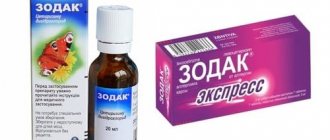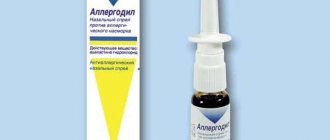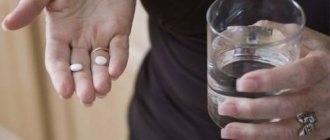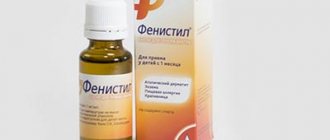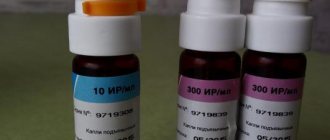Zodak drops for children: instructions for use
You can also put drops directly from the bottle into the baby's mouth.
In this case, you need to hold the bottle so that the dropper pipette does not come into contact with the child’s mouth to avoid contamination of the solution. After the drug has been prepared for use, it should be drunk immediately. Do not pour measured drops back into the bottle to avoid contamination of the drops.
According to instructions
- In infants from 6 months to 1 year, the drug can be used only according to strict indications and under the supervision of a physician.
- Dose for children aged 6 to 12 months: 2.5 mg (5 drops) 1 time per day.
- Dose for children aged 1 to 6 years: 2.5 mg (5 drops) 2 times a day.
- Children from 6 to 12 years old are given drops in a dose of 5 mg (10 drops) 2 times a day.
- Children over 12 years of age, the dose per dose is 10 mg (20 drops), this dose is given once a day.
- For children with liver and kidney failure, the dose is adjusted by the doctor.
If the drug is given to the child twice a day, then it will be most convenient to space the administration time by 12 hours - in the morning and in the evening: this way the medicine will enter the body gradually and evenly.
In some cases, reduction or elimination of allergy symptoms is possible after taking an initial dose of 5 mg (10 drops). In this case, the doctor may decide that this dosage is sufficient.
If, after reducing the dose, it suddenly turns out that the effectiveness of controlling allergy symptoms has decreased and the child is again bothered by some manifestation of an allergic disease, then you need to notify the doctor about this so that he can adjust the dose.
If the time for taking the drops was missed, then the missed dose should be given immediately after the omission was discovered. If more than 8 hours have passed since the missed dose, then there is no need to give the missed dose, and at the next scheduled dose, give one dose, without changing or increasing the dose by one dose.
The bottle is equipped with a system that prevents children from opening the cap. To open it, you need to press the lid firmly downwards and then turn it counterclockwise. The lid is also unscrewed counterclockwise until the end. Accordingly, after use, screw the cap in a clockwise direction.
Contraindications
As indicated in the instructions, the drug is not used if the main active ingredient is cetirizine, as well as hydroxyzine and other piperazine derivatives.
Do not use in case of hypersensitivity or intolerance to the auxiliary components of the drug.
Contraindicated in renal failure and creatinine clearance less than 10 milliliters per minute.
Not for use in infants under 6 months.
Not prescribed during pregnancy.
The product should be used with caution in the following cases:
- Chronic renal failure with creatinine clearance greater than 10 milliliters per minute. Dose adjustment is required in accordance with clearance and body weight.
- In elderly people with decreased renal filtration.
- In patients with epilepsy, episyndrome and increased convulsive readiness.
- In patients with diseases that can cause urinary retention, the use of Zodak® drops is possible only under strict indications.
- For children under 1 year of age, it is prescribed only by doctor’s decision, if necessary and if there are indications for use.
- During breastfeeding, since the drug passes into breast milk and can have an effect on the baby’s body.
Up to a year, the prescription of cetirizine-based drugs should be carried out only by a doctor and only according to strict indications. They may be deeply oppressed by an unequal system, which may become one of the factors that increases the risk of developing sudden infant death syndrome (SIDS) in the presence of other risk factors for this syndrome:
- sleep apnea syndrome;
- SIDS in infancy that occurred in a brother or sister of the child;
- maternal drug use or smoking during pregnancy;
- a child born to a mother aged 19 years or younger;
- a person caring for a child (mother, father, grandmother, nanny, etc.) smokes more than a pack of cigarettes a day;
- the child regularly sleeps on his stomach;
- the child is not placed on his back;
- prematurity before the 37th week of pregnancy (weight less than 2500 g);
- the child was born underweight.
- If at the same time the child is prescribed drugs that have a depressing effect on the central nervous system.
Side effects
Taking cetirizine solution - Zodak® - in therapeutic doses can lead to the development of mild side effects.
From the side of the nervous system, the following are possible: a feeling of fatigue, drowsiness, dizziness, transient headache. Sometimes there may be increased excitability due to stimulation of the central nervous system.
The active ingredient of the drug has virtually no effect on the cholinergic system, but difficulty urinating, double vision and blurred vision may occur due to impaired accommodation, dry mouth and nose.
There may be side effects from the digestive system - abdominal pain, nausea, diarrhea.
The drug contains excipients methylparabenzene and propylparabenzene, which can cause allergic reactions, including delayed ones.
Overdose: symptoms and help
In case of an overdose, the following symptoms are possible: confusion, lethargy, dizziness and headache, excessive drowsiness, stupor and stunned state, physical weakness and fatigue, anxiety, the effect of sedation with drowsiness, dilated pupils, itching of the skin and mucous membranes, rapid heartbeat, hand tremors, difficulty urinating, bowel problems such as diarrhea or constipation.
Providing assistance and treatment in case of overdose before the arrival of a doctor or ambulance begins with gastric lavage using an accessible method. Give activated carbon in an age-appropriate dosage. In the hospital, therapy is provided to relieve symptoms.
There is no known antidote for cetirizine. Hemodialysis in case of an overdose of this drug is ineffective.
Interaction with other drugs
According to research, cetirizine practically does not interact with other drugs.
Caution is required when using Zodak® simultaneously with other drugs that can depress the nervous system and cause a sedative effect. They can mutually enhance their effect.
The drug is not compatible with alcohol, including medications that contain ethyl alcohol.
Storage conditions
Can be stored under normal household conditions. The drug should be kept out of the reach of children.
Terms of sale
Sold through pharmacy chains without a doctor's prescription.
Source: https://allergia.pro/articles/detskaya-instruktsiya-zodak/
Side effects
Taking cetirizine solution - Zodak® - in therapeutic doses can lead to the development of mild side effects.
From the side of the nervous system, the following are possible: a feeling of fatigue, drowsiness, dizziness, transient headache. Sometimes there may be increased excitability due to stimulation of the central nervous system.
The active ingredient of the drug has virtually no effect on the cholinergic system, but difficulty urinating, double vision and blurred vision may occur due to impaired accommodation, dry mouth and nose.
There may be side effects from the digestive system - abdominal pain, nausea, diarrhea.
The drug contains excipients methylparabenzene and propylparabenzene, which can cause allergic reactions, including delayed ones.
According to research, cetirizine practically does not interact with other drugs.
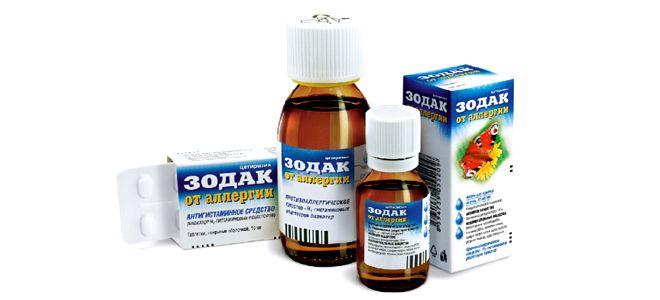
Caution is required when using Zodak® simultaneously with other drugs that can depress the nervous system and cause a sedative effect. They can mutually enhance their effect.
The drug is not compatible with alcohol, including medications that contain ethyl alcohol.
Zodak drops: instructions for use for children, composition, dosage, analogues
Drops against allergies based on cetirizine. The children's form of release makes it possible to use Zodak from 2 years of age. When used correctly, side effects are extremely rare. The drug effectively relieves itching and swelling. Does not accumulate in the body. The single dosage and frequency of administration are determined by the doctor. May cause side effects on other organs and systems.
Description and composition
Zodak drops for children are produced by pharmaceutical companies, the country of origin is the Czech Republic.
The active ingredient of the drug is cetirizine dihydrochloride, which is a selective blocker of H1-histamine peripheral receptors of the 2nd generation.
The substance does not have significant anticholenergic and antiserotonin effects, which makes the drug more effective and safe for use in childhood compared to 1st generation antihistamines.
Excipients: purified water, glycerol, methyl parahydroxybenzoate, sodium saccharin dihydrate, glacial acetic acid, propyl parahydroxybenzoate, sodium acetate trihydrate, propylene glycol. Additional substances are necessary to create a convenient dosage form, extend the maximum shelf life, and increase the effectiveness of the active substance in the drug.
special instructions
The daily dose of syrup (10 ml) contains 3000 mg of sorbitol, which corresponds to 0.25 XE (bread unit). The drops do not contain sugar, so Zodak in this dosage form can be taken by patients with diabetes.
It is not recommended to take Zodak simultaneously with drugs that depress the central nervous system, as well as with alcohol.
During the period of therapy, it is recommended to refrain from performing potentially dangerous types of work that require high concentration and rapid psychomotor reactions.
Pharmacological group
Zodak drops for children belong to the 2nd generation antihistamine group of drugs.
Pharmacodynamics
The active ingredient, cetirizine dihydrochloride, selectively blocks peripheral H1-histamine receptors and competes with the effects of histamine.
This leads to the elimination of an allergic reaction in the body and an improvement in general condition.
The drug substance reduces the activity of eosinophils and basophils in the skin and mucous membranes, which prevents allergic damage to the eyes, upper respiratory tract, and skin.
In therapeutic age doses, Zodak prevents the development of seasonal and atopic rhinitis, conjunctivitis, bronchial asthma, urticaria, allergic dermatitis, and eczema.
Cetirizine has an anti-edematous and anti-inflammatory effect, improves airway patency, reduces the formation of inflammatory discharge from the nose and eyes, prevents skin rashes, and soothes itching and itching.
Pharmacokinetics
Zodak drops are intended for oral use. After entering the digestive tract, the drug is absorbed in the stomach, penetrates into the general bloodstream (systemic action), and binds to transport proteins in the blood by 93%.
In clinical trials, no effect of cetirizine on the combination of warfarin with transport albumins was revealed. The maximum concentration of the drug in the blood plasma is achieved after 30-90 minutes. The rate of absorption is affected by the use of drops with food.
Taking with food prolongs the rate of absorption, but does not affect the concentration of the drug in the blood plasma.
Cetirizine is largely not metabolized in the liver. The drug is excreted by the kidneys 2/3 unchanged. No accumulation of cetirizine in the body was detected.
Violation of the pharmacokinetics of the drug develops in renal failure. When creatinine clearance is less than 10 ml/minute, cetirizine is not excreted and has a toxic effect on organs and tissues.
The half-life of the drug from the body in children is 3 hours, in adults on average 10 hours.
Composition of the drug
The active ingredient in the drug is the powerful antihistamine cetirizine dihydrochloride.
1 ml of solution contains 10 mg of antiallergic agent. The solution form is provided by the following auxiliary components: methylparaben, glycerin, propylene glycol, saccharin and water. The drug is available in 20 ml tinted glass bottles.
The drug in drops has a rapid action, since the active component is already absorbed in the oral cavity and esophagus, so pediatricians prefer this form of release.
The active substance is an antagonist of peripheral H1 receptors. The drug also has an anti-inflammatory effect, affecting the corresponding cells of the body. Taking a therapeutic dose of the drug blocks the formation of an allergic rash caused by excess histamine in the cells of the epidermis.
The peculiarity of the medicine is its rapid action. On average, the drug begins to “work” half an hour after taking a therapeutic dose (the action begins within 20–50 minutes after administration). The effect lasts for a full day, which makes it convenient to treat seasonal allergic reactions with this drug, during which it is important to ensure the constant effect of the antihistamine.
A long-term study of the effect on the body of children aged 5 - 10 years did not reveal the development of tolerance to the antihistamine effect of the drug over time. In other words, the effectiveness does not decrease with long-term use, so the drug is suitable for the treatment of seasonal allergies.
Indications for use
Zodak drops for children are prescribed by a doctor after examining the child and conducting additional diagnostic methods. The drug is used for allergic conditions of a seasonal intermittent (during flowering plants) or persistent (in contact with an allergen year-round) nature. Indications for prescribing Zodak drops:
- allergic rhinitis (tingling and itching in the nose, mucous discharge from the nasal passages, sneezing);
- allergic conjunctivitis (redness of the mucous membrane of the eyes, itching, lacrimation, photophobia);
- allergic rash (urticaria, dermatitis, eczema);
- bronchial asthma (difficulty in breathing, unproductive cough, feeling of lack of air, wheezing in the lungs);
- idiopathic urticaria (skin lesions and fever).
Zodak drops are effective and safe for use in children aged 1 year and older.
Source: https://guzgb6.ru/lekarstva/zodak-detskij-instrukciya-po-primeneniyu.html
Drops for children Zodak - instructions for use
Zodak drops are an anti-allergy medicine that is suitable for children from the first year of life. The drug effectively relieves itching, irritation and swelling, and does not accumulate in the body. Correct use very rarely causes side effects. Instructions for use of Zodak for children will help determine the correct dosage and effectively eliminate allergy symptoms in the baby.
About the drug
Zodak drops ease the course of allergies, help prevent the onset of symptoms, relieve spasms of mucous tissues, and help quickly relieve swelling.
The effect of the medicine appears within 30-60 minutes after use. The accumulating effect allows you to use the drug until you feel completely better. The half-life of the drug is 10 hours from the moment of administration.
The drug is produced by a pharmaceutical company, produced in the Czech Republic.
Compound
The main active ingredient is cetirizine dihydrochloride, which is a 2nd generation H1-histamine receptor blocker. Due to the use of this substance, the drug is more effective and safe for children than 1st generation antihistamines.
Excipients:
- glycerol;
- propylene glycol;
- sodium saccharinate dihydrate;
- methyl parahydroxybenzoate;
- propyl parahydroxybenzoate;
- glacial acetic acid;
- purified water.
Excipients help extend shelf life, increase the effectiveness of the active substance and create a convenient dosage form in the form of drops.
Release form
Zodak drops are available in 20 ml dark brown glass bottles with a dropper dispenser. The bottle is placed in a cardboard box. The drops are transparent, colorless or light yellow.
The bottle cap is equipped with a child-proof mechanism. To open the bottle, you need to press the cap and turn it counterclockwise. To close the bottle, screw the cap clockwise.
There are other forms of release of the drug "Zodak" - these are tablets and syrup.
Zodak for children detailed instructions for use
Zodak drops for children can be taken at any convenient time, however, with a single use during the day, pediatricians advise giving the drops to the child in the evening.
If the drops are taken twice during the day, then the time to take the medicine is morning and evening. The standard treatment period with Zodak drops is 7-10 days.
The period of use of the medicine can be adjusted by the doctor. Dosage depends on age:
Children's age Dosage in drops How many times a day to take
| 1-2 years | 5 | 2 |
| 2-6 years | 10 | 1 |
| 6-12 years | 20 | 1 |
| Over 12 years old | 20 | 1 |
The drops must be dissolved in a small amount of water that the child can drink at one time. For the youngest patients, the medicine is dissolved in a spoon.
Zodak drops for children under one year old
The manufacturer does not recommend using this medicine for children under one year of age. It is not for nothing that the list of contraindications includes children under 1 year of age. The medicine can depress the central nervous system, which causes difficulty breathing in the child.
However, the risk of negative effects on the nervous system is very small, so pediatricians often still prescribe these drops to infants, provided that the potential benefits of taking the medicine outweigh the possible harm.
Zodak drops are prescribed to children under one year of age, subject to constant monitoring of the baby’s condition (breathing, heartbeat). If any negative manifestations are detected, the drug is discontinued.
When used in infants, the medicine is either mixed into the first portion of baby food or instilled into the nasal passages. How many drops of Zodak should a child under one year of age be given:
Children's age Dosage in drops How many times a day to take
| Up to 3 months | 2 | 1 |
| From 3 to 6 months | 3-4 | 1 |
| From 6 to 12 months | 5 | 1 |
Side effects
Instructions for using Zodak drops for children indicate the possible occurrence of the following side effects:
- dry mouth;
- dyspnea;
- stomach ache;
- nausea;
- headache;
- dizziness;
- fatigue;
- drowsiness;
- drug pharyngitis;
- diarrhea.
Side effects are rare and the condition completely normalizes after discontinuation of the drug.
Overdose
If the dose of the drug is significantly exceeded (5 times or more), a clinically significant overdose occurs. Therefore, it is important to carefully study the instructions and write down the doctor’s recommendations in order to know how many Zodak drops are safe for children to take. Overdose symptoms are as follows.
From the central nervous system:
- drowsiness;
- stupor;
- tremor;
- headache;
- confusion.
From the gastrointestinal tract:
- abdominal cramps;
- dry mouth;
- diarrhea.
Tachycardia (increased heart rate) and urinary retention are also observed.
A mandatory action in case of overdose is immediate gastric lavage. It is necessary to induce vomiting, and then give the patient activated carbon or another sorbent.
Price
The price of the drug varies from 180 to 250 rubles. The average cost is 205 rubles.
Analogs
Analogues of the drug are:
- "Zyrtec";
- "Parlazin";
- "Cetirizine";
- "Fenistil";
- "Loratadine";
- "Claritin";
- "Peritol".
Today there are many antihistamines. However, not all of them are safe when conducting antiallergic therapy in young children.
Zodak in the form of drops is relatively safe for children, therefore it is one of the most common medicines. It effectively eliminates allergy symptoms in children and adults.
But it is worth remembering that before use you must consult your doctor.
0
0
17982
Source: https://littleone.com/publication/0-6086-kapli-dlya-detey-zodak-instrukciya-po-primeneniyu
Overdose: symptoms and help
In case of an overdose, the following symptoms are possible: confusion, lethargy, dizziness and headache, excessive drowsiness, stupor and stunned state, physical weakness and fatigue, anxiety, the effect of sedation with drowsiness, dilated pupils, itching of the skin and mucous membranes, rapid heartbeat, hand tremors, difficulty urinating, bowel problems such as diarrhea or constipation.
Providing assistance and treatment in case of overdose before the arrival of a doctor or ambulance begins with gastric lavage using an accessible method. Give activated carbon in an age-appropriate dosage. In the hospital, therapy is provided to relieve symptoms.
There is no known antidote for cetirizine. Hemodialysis in case of an overdose of this drug is ineffective.
Zodac®
Latest update of the description by the manufacturer 02.09.2019
Cetirizine* R06AE07 Cetirizine
| Drops for oral administration | 1 ml |
| active substance: | |
| cetirizine dihydrochloride | 10 mg |
| excipients: methyl parahydroxybenzoate; propyl parahydroxybenzoate; glycerol; propylene glycol; sodium saccharinate dihydrate; sodium acetate trihydrate; glacial acetic acid; purified water |
Drops:
transparent, colorless to light yellow solution.
Pharmacological action - antiallergic.
Cetirizine is a metabolite of hydroxyzine, belongs to the group of competitive histamine antagonists and blocks H1-histamine receptors.
In addition to the antihistamine effect, cetirizine prevents the development and alleviates the course of allergic reactions: at a dose of 10 mg 1 or 2 times a day, it inhibits the late phase of eosinophil aggregation in the skin and conjunctiva of patients prone to atopy.
Clinical efficacy and safety.
Studies in healthy volunteers have shown that cetirizine at doses of 5 or 10 mg significantly inhibits the rash and redness response to high concentrations of histamine in the skin, but the correlation with efficacy has not been established.
A 6-week placebo-controlled study involving 186 patients with allergic rhinitis and concomitant mild to moderate bronchial asthma showed that cetirizine 10 mg once daily reduced symptoms of rhinitis and did not affect pulmonary function.
The results of this study confirm the safety of cetirizine in patients suffering from allergies and mild to moderate bronchial asthma.
A placebo-controlled study showed that taking cetirizine at a dose of 60 mg/day for 7 days did not cause a clinically significant prolongation of the QT interval. Taking cetirizine at the recommended dose showed an improvement in the quality of life of patients with year-round and seasonal allergic rhinitis.
Children.
In a 35-day study in patients aged 5–12 years, there was no evidence of resistance to the antihistamine effect of cetirizine. The normal skin reaction to histamine was restored within 3 days after discontinuation of the drug with repeated use.
A 7-day placebo-controlled study of cetirizine in syrup dosage form involving 42 patients aged 6 to 11 months demonstrated the safety of the drug.
Cetirizine was prescribed at a dose of 0.25 mg/kg twice daily, which corresponds to approximately 4.5 mg per day (dose range was 3.4 to 6.2 mg per day).
Use in children from 6 to 12 months is possible only as prescribed by a doctor and under strict medical supervision.
The pharmacokinetic parameters of cetirizine when used in doses from 5 to 60 mg change linearly.
Suction.
Cmax in blood plasma is reached after (1±0.5) hours and is 300 ng/ml.
Various pharmacokinetic parameters, such as plasma Cmax and AUC, are uniform in nature.
Food intake does not affect the complete absorption of cetirizine, although its rate decreases. The bioavailability of various dosage forms of cetirizine (solution, capsules, tablets) is comparable.
Distribution.
Cetirizine is (93±0.3)% bound to blood plasma proteins.
Vd is 0.5 l/kg. Cetirizine does not affect the protein binding of warfarin.
Metabolism.
Cetirizine does not undergo extensive first-pass metabolism.
Excretion.
T1/2 is approximately 10 hours.
When taking the drug at a daily dose of 10 mg for 10 days, no accumulation of cetirizine was observed.
Approximately 2/3 of the dose taken is excreted unchanged in the urine.
Elderly patients.
In 16 elderly patients, with a single dose of 10 mg, T1/2 was 50% higher and clearance was 40% lower compared to non-elderly patients. The decreased clearance of cetirizine in elderly patients is likely due to decreased renal function in this category of patients.
Kidney failure.
In patients with mild renal failure (Cl creatinine >40 ml/min), pharmacokinetic parameters are similar to those in healthy volunteers with normal renal function.
In patients with moderate renal failure and in patients on hemodialysis (Cl creatinine
Source: https://www.rlsnet.ru/tn_index_id_23392.htm
